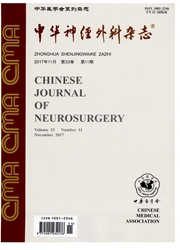

 中文摘要:
中文摘要:
目的探讨垂体生长激素(GH)腺瘤患者心肌早期复极综合征(ERS)的发生率及其危险因素。方法前瞻性纳入2014年8月至2016年8月中山大学附属第一医院神经外科、垂体腺瘤诊治中心收治的103例垂体GH腺瘤患者(简称GH腺瘤组)和99例垂体无功能性腺瘤患者(简称无功能性腺瘤组)。对比两组的左心室质量指数(LVMI)、瓣膜疾病发生率、心肌缺血发生率以及ERS发生率,采用Logistic回归分析探讨垂体GH腺瘤患者发生ERS的危险因素。结果与无功能性腺瘤组相比,GH腺瘤组的GH水平、胰岛素样生长因子1(IGF-1)水平、LVMI以及ERS发生率显著升高(均P〈O.05),其中两组的ERS发生率分别为35.0%(36/103)和13.1%(13/99)。Logistic回归分析表明,LVMI为ERS发生的独立危险因素(OR=1.012,95%CI:1.003~1.021,P=0.012)。双变量关联性分析表明,病程(r=0.287,P〈0.01)、血清GH水平(r=0.310,P〈0.01)、血清IGF-1水平(r=n282,P〈0.01)、是否合并糖尿病(r=0.247,P〈0.01)与LVMI相关;多元线性回归分析表明,病程和血清IGF-1水平为LVMI的正相关因素(均P〈0.05)。结论与垂体无功能性腺瘤患者相比,垂体GH腺瘤患者出现ERS的比率显著增加;血清GH、IGF-1、血糖持续升高,导致心肌细胞肥大和LVMI增加,可能是其ERS发生率增高的原因之一。
 英文摘要:
英文摘要:
Objective To study the incidence rate and risk factors of early repolarization syndrome (ERS) in patients with growth hormone-secreting pituitary adenomas. Methods A total of 103 patients with pituitary growth hormone (GH) adenomas (GH adenoma group) and 99 patients with pituitary nonfunctional adenomas (nonfunctional adenoma group) admitted to Department of Neurosurgery, Pituitary Tumor Center, the First Affiliated Hospital, Sun Yat-sen University, from August 2014 to August 2016 were prospectively enrolled. Comparison was conducted about the difference of left ventricular mass index (LVMI) , prevalence of valvular disease, incidence of myocardial ischemia and incidence of ERS between the two groups. The risk factors of ERS in patients with growth hormone-secreting pituitary adenomas were investigated by Logistic regression analysis. Results Compared with pituitary nonfunctional adenomas, the growth hormone ( GH), insulin-like growth factor-1 (IGF-1), LVMI and ERS were significantly increased in pituitary growth hormone adenomas (all P〈0.05), and the incidences of ERS were 35.0% (36/103) and 13.1% (13/99) in pituitary growth hormone adenomas and pituitary nonfunctional adenomas, respectively. The results of Logistic regression analysis showed that LVMI was an independent risk factor for ERS ( OR = 1. 012, 95% CI: 1. 003 - 1. 021, P = 0. 012). The results of the bivariate correlation analysis showed that the duration of disease (r =0. 287, P 〈0.01 ), serum GH (r =0.310, P 〈0. 01), IGF-1 (r =0. 282, P 〈0. 01) and diabetes mellitus (r =0. 247, P 〈0.01) were associated with LVMI. The results of multivariate linear regression analysis demonstrated that the duration of disease and IGF-1 were positive risk factors of LVMI ( all P 〈 0.05 ). Conclusions Compared with that in pituitary nozffunctional adenomas, the incidence of ERS is significantly higher in pituitary growth hormone adenomas. Serum GH, IGF-1 and blood glucose demonstrate continuo
 同期刊论文项目
同期刊论文项目
 同项目期刊论文
同项目期刊论文
 期刊信息
期刊信息
